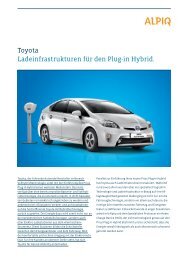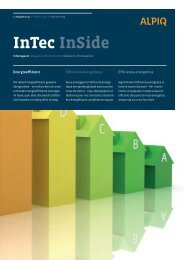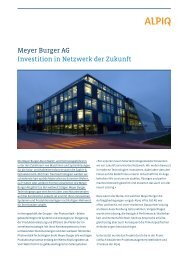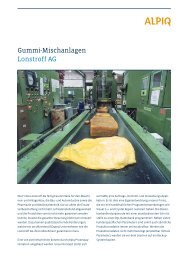Electric vehicle market penetration in Switzerland by 2020 - Alpiq
Electric vehicle market penetration in Switzerland by 2020 - Alpiq
Electric vehicle market penetration in Switzerland by 2020 - Alpiq
- No tags were found...
You also want an ePaper? Increase the reach of your titles
YUMPU automatically turns print PDFs into web optimized ePapers that Google loves.
<strong>Electric</strong> <strong>vehicle</strong> <strong>market</strong> <strong>penetration</strong><strong>in</strong> <strong>Switzerland</strong> <strong>by</strong> <strong>2020</strong>We cannot forecast the future but we can prepare for it
Index568122225301. <strong>Alpiq</strong>. A new energy leader2. <strong>Switzerland</strong>’s energy challenges and objectives3. <strong>Alpiq</strong>’s energy strategy4. <strong>Alpiq</strong> supports electric <strong>vehicle</strong>s5. VISION <strong>2020</strong> for future clean mobility6. Meet<strong>in</strong>g VISION <strong>2020</strong>7. Next steps
Atel & EOS jo<strong>in</strong> forces to create <strong>Alpiq</strong>, a newenergy leader for <strong>Switzerland</strong> and Europe.We comb<strong>in</strong>e power generation, transmission,sales & trad<strong>in</strong>g and energy services <strong>in</strong>to acomprehensive offer<strong>in</strong>g of energy solutions.
1. <strong>Alpiq</strong>. A new energy leaderAs a lead<strong>in</strong>g national energy company, <strong>Alpiq</strong> is readyto play an important, proactive role <strong>in</strong> provid<strong>in</strong>geconomically feasible solutions for ensur<strong>in</strong>g securityof energy supply and reduc<strong>in</strong>g greenhouse gas (GHG)emissions.• Present <strong>in</strong> 30 European countries• Cumulated turnover of CHF 15.8 billion <strong>in</strong> 2008• Workforce of more than 10,000employees (<strong>in</strong> <strong>Switzerland</strong> > 5,000)Power generationEnergy servicesSales & trad<strong>in</strong>g5
2. <strong>Switzerland</strong>’s energy challengesand objectivesChart 1: Primary energy balance sheet219.7719 %633.9256 %2.1 High dependence on fossil energy<strong>Switzerland</strong> is highly dependent on fossil energy imports.Foreign oil and gas currently account for 56 % of thecountry’s primary energy consumption. Domestic energyresources are limited to 19 % of national use, of whichhydroelectricity resources are predom<strong>in</strong>ant with 11.5 %.287.9925 %Fossil energy Nuclear fuel Domestic resourcesSource: Swiss energy statistics 2007, SFOE2.2 Latent risk with fossil energy importsAfter the dramatic surge of crude oil prices <strong>in</strong> the summerof 2008, the global recession caused oil prices to plunge to$ 40/bbl. But prices will doubtlessly <strong>in</strong>crease rapidly aga<strong>in</strong>once the economy recovers. Some experts1 forecast a priceof $ 200/bbl <strong>by</strong> 2030.Chart 2: Crude oil pricesBrent crude $/bbl250200150?In the long term, once peak oil is passed there will ensuean <strong>in</strong>evitable and irreversible cost <strong>in</strong>crease of petrol-basedfuels. This rise will last several decades before oil f<strong>in</strong>allyruns out completely.100502000 2005 2010 2015 <strong>2020</strong> 2025 20301See IEA World Energy Outlook 20086
2.3 <strong>Switzerland</strong>’s energy strategyThe energy challenges to be met <strong>by</strong> <strong>Switzerland</strong> are twofold:• Mitigation of the peak oil threat and ensu<strong>in</strong>g drasticprice <strong>in</strong>crease <strong>by</strong> reduc<strong>in</strong>g <strong>Switzerland</strong>’s dependency onoil & gas• Meet<strong>in</strong>g the climate challenge <strong>by</strong> significantly reduc<strong>in</strong>gnational GHG emissionsThe Swiss government accord<strong>in</strong>gly published its energystrategy at the beg<strong>in</strong>n<strong>in</strong>g of 2007, based on four pillars:• Increased energy efficiency and control of growth <strong>in</strong>energy demand• Increased share of renewable energy• Construction of large electricity generation plants to replaceag<strong>in</strong>g nuclear plants and construction of comb<strong>in</strong>edcycle gas turb<strong>in</strong>e (CCGT) plants as a transitory solution• Strengthen<strong>in</strong>g of <strong>in</strong>ternational collaborationMuch will therefore depend on the outcomes of the EUClimate and Energy package and the 2009 COP 2 post-KyotoProtocol <strong>in</strong>ternational discussions <strong>in</strong> Copenhagen. However,the global climate issue is already well known: theprevention of dangerous climate <strong>in</strong>terference requires areduction <strong>in</strong> worldwide CO2 emissions to around 23 billionstons <strong>by</strong> 20303, equivalent to the level of 2005 emissions.This is an enormous challenge for which <strong>Switzerland</strong> willhave to do its share.The Swiss climate strategy will be addressed <strong>by</strong> Parliament<strong>in</strong> 2009/2010. The two alternative solutions proposed <strong>by</strong>the Swiss government consist of 1) an alignment withEU climate policy for a 20 % reduction <strong>in</strong> greenhouse gas(GHG) emissions <strong>by</strong> <strong>2020</strong>, obta<strong>in</strong>ed primarily <strong>by</strong> domesticmeasures, and 2) a more ambitious reduction of 50 % <strong>by</strong><strong>2020</strong>, ma<strong>in</strong>ly through concerted measures at the <strong>in</strong>ternationallevel.2Annual Conference of the Parties to the Kyoto Protocol3Source: International Panel on Climate Change (IPCC)7
3. <strong>Alpiq</strong>’s energy strategy3.1 Need for a global approachS<strong>in</strong>ce constra<strong>in</strong><strong>in</strong>g energy demand <strong>by</strong> limit<strong>in</strong>g consumptionis socially undesirable and politically difficult toimplement, effort must be focused on improv<strong>in</strong>g energyefficiency.This approach is based on <strong>Switzerland</strong>’s “global energyeng<strong>in</strong>e” where, from primary energy resources 4, everyeconomic agent is supplied with the energy 5 required,when, where, <strong>in</strong> the form and <strong>in</strong> the amount needed.Reduc<strong>in</strong>g <strong>Switzerland</strong>’s dependence on fossil energy isa challenge of major importance.Increas<strong>in</strong>g energy efficiency correlates to the lower<strong>in</strong>gof transformation losses from primary energy to usefulenergy.Chart 3: <strong>Switzerland</strong>’s global energy systemCoalCrude oilRef<strong>in</strong><strong>in</strong>gHous<strong>in</strong>gCCF CAD*Oil productsIndustryOil productsNatural gasServicesPrimary energyNuclear fuelHydroenergypower plantpower plantImportsExports<strong>Electric</strong>ityTransformed energyF<strong>in</strong>al energyTransportUseful energyOther renewable energiesLossesLossesPrimaryenergyTransformedenergyF<strong>in</strong>alenergyLossesUsefulenergy*CHP-Long-Distance Heat<strong>in</strong>g4For example: oil, natural gas, coal, uranium (nuclear), w<strong>in</strong>d, solar, geothermal, hydro5For example: dwell<strong>in</strong>g and office heat & light, transportation8
3.2 The role of electricity<strong>Electric</strong>ity can provide a new solution for secur<strong>in</strong>g competitiveenergy <strong>in</strong> a fossil fuel and carbon-constra<strong>in</strong>edworld, especially <strong>in</strong> <strong>Switzerland</strong> where electricity generationis almost free of CO2.<strong>Electric</strong>ity, which is not a primary energy but a transformedenergy, can be produced from nearly all primary sources.<strong>Electric</strong>ity can therefore <strong>in</strong>tegrate the majority of renewableenergy sources and gradually contribute to the green<strong>in</strong>gof the global energy system.Electrify<strong>in</strong>g the economy <strong>in</strong> an <strong>in</strong>telligent manner holdsgreat potential for energy sav<strong>in</strong>gs through superiorefficiency <strong>in</strong> the transformation of primary energy <strong>in</strong>touseful energy.<strong>Alpiq</strong>’s strategy is aimed at secur<strong>in</strong>g <strong>Switzerland</strong>’s electricitysupply and ma<strong>in</strong>ta<strong>in</strong><strong>in</strong>g domestic low-carbon electricitygeneration <strong>in</strong> a diversified mix, us<strong>in</strong>g all available options:• Increas<strong>in</strong>g the share of renewables (hydro and othersources)• Replac<strong>in</strong>g ag<strong>in</strong>g nuclear power plants• Us<strong>in</strong>g clean fossil fuel Comb<strong>in</strong>ed Cycle Gas Turb<strong>in</strong>e (CCGT)plants as a transitory solution.3.3 Smart grid: potential improvement at handThe Swiss power network is <strong>in</strong>terconnected to the Europeangrid <strong>in</strong> a system that, with outstand<strong>in</strong>g efficiencyand reliability, is capable of deliver<strong>in</strong>g just-<strong>in</strong>-time energywhenever and wherever it is needed. This fantastic mechanismsupplies each household with power 24 hours a day.Indeed, very substantial progress <strong>in</strong> terms of energy efficiency,CO2 emissions and reduc<strong>in</strong>g oil and gas dependencycan be achieved through the <strong>in</strong>telligent electrification ofthe Swiss economy, particularly <strong>in</strong> two areas:• Heat<strong>in</strong>g and cool<strong>in</strong>g through the use of heat pumps <strong>in</strong>the residential sector• Pluggable electric cars for private transportationThe replacement of less efficient electro-technologies(<strong>in</strong>candescent lightn<strong>in</strong>g, direct electric heat<strong>in</strong>g, stand<strong>by</strong>power, etc.) with more efficient electro-technologiesmust also be accelerated.The <strong>in</strong>tegration of clean, renewable sources of energy likesolar, w<strong>in</strong>d and geothermal will require the power grid todevelop a more advanced delivery network, with the abilityto support a two-way flow of <strong>in</strong>formation and electricity.This “smart grid” will <strong>in</strong>corporate the benefits of distributed<strong>in</strong>telligence, comput<strong>in</strong>g and communication andwill facilitate the power balance between supply anddemand at the device level. The “smart grid” will also help<strong>in</strong>crease energy efficiency <strong>by</strong> reduc<strong>in</strong>g f<strong>in</strong>al energy(commercial energy) needs and expenses for all economicagents.9
4. <strong>Alpiq</strong> supports electric <strong>vehicle</strong>sChart 4: Sources of greenhouse gas (GHG) emissions% of total anthropogenic emissions353025201510525.6 %2 %Energy production13.1 %30.1 %Transportation7.9 %World (IPCC 2004) <strong>Switzerland</strong> (SFOE 2006)31.4 %Residential/commercial build<strong>in</strong>gs4.1 In <strong>Switzerland</strong>, electricity is part of the solution, notpart of the problem• Sources of greenhouse gas (GHG) emissions <strong>in</strong> <strong>Switzerland</strong>differ considerably from the world situation (chart 4):• The energy sector is negligible <strong>in</strong> <strong>Switzerland</strong> with 2.7 %of GHG emissions, while it is a major component (¼)over the entire world.• The transport sector accounts for ⅓ of GHG emissions <strong>in</strong><strong>Switzerland</strong> compared to slightly over 1/10 worldwide.This clearly illustrates that the Swiss climate policy shouldfocus on those sectors emitt<strong>in</strong>g large amounts of GHG, suchas hous<strong>in</strong>g and transportation.Contrary to the global situation, electricity generation isnot a CO2 issue <strong>in</strong> <strong>Switzerland</strong>.12
Chart 5: Swiss CO2 emissions (Energy use)Millions of tons per year454035302520151051975 1980 1985 1990 1995 2000 2005 2010TotalRoad transportHeat processAir transportSource: Ecoplan, “CO 2-Emissionen 2008 – 2012”, Annual report,SFOE September 2008Chart 6: Variation 1990 – 20074.2 The problem of <strong>in</strong>creas<strong>in</strong>g road transport CO2 emissionsIn the EU, emissions of CO2, the most important GHG, havebeen grow<strong>in</strong>g quickly <strong>in</strong> road transportation, whereasthe emissions trend rema<strong>in</strong>s steady or is even decreas<strong>in</strong>g<strong>in</strong> the other sectors.The situation is similar <strong>in</strong> <strong>Switzerland</strong> (chart 5). S<strong>in</strong>ce CO2emissions <strong>in</strong> transportation cont<strong>in</strong>ue to grow (+14.3 %,1990 – 2007), total Swiss emissions of CO2 from energy usehave rema<strong>in</strong>ed steady at around 39 million t CO2/yeardespite a significant reduction <strong>in</strong> the <strong>in</strong>dustrial and residentialsectors dur<strong>in</strong>g the last decade (– 14.6 %, 1990 – 2007,chart 6).Clearly, the focus of the Swiss climate strategy should beset on CO2 emissions <strong>in</strong> the road transportation sector(44 % of total Swiss emissions <strong>in</strong> 2007) and on private cars<strong>in</strong> particular, the greatest source (72 %) of CO2 emissions<strong>in</strong> the sector (chart 7).Percentage15105+14.3 %Chart 7: Road transport CO2 emissions (2007)7 %–5–10–14.6 %–15Heat processRoad transport13 %8 %72 %Source: Ecoplan, “CO 2-Emissionen 2008 – 2012”, Annual report,SFOE September 2008Private cars Vans (delivery) Trucks and bussesOtherSource: Metron Ecoplan “Handelbare Vebrauchsgutschriften fürNeuwagen”, Greenpeace CH, January 200913
4.3 The importance of consider<strong>in</strong>g the global energy cha<strong>in</strong>In order to evaluate and compare the environmental impactof a <strong>vehicle</strong> concept, energy consumption and emission<strong>in</strong>tensity must be considered from the source of the primaryenergy carrier (well) to the end user (wheel of the <strong>vehicle</strong>).The Well-to-Wheel (WtW) evaluation is the sum of theWell-to-Tank (energy expended and the associated greenhousegas (GHG) emitted <strong>in</strong> the steps required to deliverthe f<strong>in</strong>ished fuel <strong>in</strong>to the onboard tank of the <strong>vehicle</strong>) andthe Tank-to-Wheel (energy expended and the associatedGHG emitted <strong>by</strong> the <strong>vehicle</strong>/fuel comb<strong>in</strong>ation) values(chart 8).When consider<strong>in</strong>g the entire energy cha<strong>in</strong> (Well-to-Wheel),the overall energy efficiency depends on the electricity generationmode, i.e. the type of generation plant and sourceof primary energy used for electricity generation.To simplify the comparison, assume that electricity is produced<strong>in</strong> a modern power plant (CCGT) with oil as the primaryenergy. In this particular example, a standard <strong>in</strong>ternalcombustion eng<strong>in</strong>e (ICE) and a battery electric <strong>vehicle</strong> (BEV)eng<strong>in</strong>e will operate from the same primary energy, that isoil. A comparison of the two energy cha<strong>in</strong>s shows that theWtW overall electric energy cha<strong>in</strong> is around twice as efficientas the traditional gasol<strong>in</strong>e cha<strong>in</strong> us<strong>in</strong>g a combustioneng<strong>in</strong>e. This results from the fact that an electric powertra<strong>in</strong> is about four times more efficient than a combustioneng<strong>in</strong>e. This results from the fact that an electric powertra<strong>in</strong> is about four times more efficient than a combustioneng<strong>in</strong>e (Tank-to-Wheel, charts 9 a – b).Chart 8: Global energy cha<strong>in</strong> Well-to-WheelWtW – Well-to-WheelPrimary energy Process<strong>in</strong>g Fuel Car+ + +WtT – Well-to-TankTtW – Tank-to-Wheel14
Chart 9 aEnergy lossENERGY %–ref<strong>in</strong>eryCO₂ emissions–– electricity gridelectricitygeneration–battery–electric motor–powertra<strong>in</strong> mechanical lossesUSEFUL ENERGYELECTRIC VEHICLE–ref<strong>in</strong>ery–diesel eng<strong>in</strong>eEnergy lossENERGY %CO₂ emissions–powertra<strong>in</strong> mechanical lossesUSEFUL ENERGY–Source: ProtoscarDIESEL VEHICLEChart 9 b: Efficiency comparisonPercentage90807080 %60504040 %30201020 %15 %ICE A categorydieselBEV withCCGTTank-to-WheelWell-to-WheelSource: Protoscar15
Chart 10: CO2 emissions for private cars <strong>in</strong> the EU contextg CO2/km200150100502005 2010 2015 <strong>2020</strong> 2025 2030EU fleet average (TtW) EV on EU-production mix (WtW)EU-target 2015 (TtW)Source: Eurelectric4.4 Carbon <strong>in</strong>tensity of European electricityThe generation fleet of European countries is not only comprisedof up-to-date, modern power plants with high efficiency.There are also plants belong<strong>in</strong>g to an older, lessefficient generation. The primary energies (coal, gas, hydro,nuclear) used are also different. The share of renewableenergies (hydro, w<strong>in</strong>d, solar, etc.) <strong>in</strong> the generation mix variesmuch across the cont<strong>in</strong>ent. Therefore, the specific CO2emissions from electricity generation (g CO2/kWh) differgreatly between European countries.In 2005, the average EU mix had specific CO2 emissions of410 g/kWh. Replac<strong>in</strong>g conventional <strong>in</strong>ternal combustioneng<strong>in</strong>e <strong>vehicle</strong>s with electric <strong>vehicle</strong>s (EVs) would result <strong>in</strong>major reductions <strong>in</strong> CO2 emissions. With the current carbon<strong>in</strong>tensity of the European electricity production mix,a typical electric car produces CO2 emissions of around80 g/km. This compares favorably to the current EU <strong>market</strong>average of CO2 emissions from passenger cars – about160 g/km.However, the European electricity sector will reduce itscarbon <strong>in</strong>tensity over com<strong>in</strong>g years, particularly with<strong>in</strong>creased use of renewables and carbon capture and storage.EURELECTRIC estimates that the carbon <strong>in</strong>tensity ofEU electricity <strong>in</strong> 2030 will dim<strong>in</strong>ish to 130 g/kWh, result<strong>in</strong>g<strong>in</strong> emissions from electric cars of less than 30 g of CO2 perkm (0.18 kWh/km EV consumption, chart 10).16
Chart 11: Swiss electricity production mix 200538 %3 % 2 %57 %Hydro Nuclear FossilsWaste cogeneration plantsSource: Swiss energy statistics 2005, SFOEChart 12: Swiss generation and consumption mix (2005)38 %/22 TWh5.4 %/3.1 TWh56.6 %/32.8 TWhNuclear imports1.55 TWhProduction57.9 TWhExports13.45 TWh21%/11.9 TWh23.55 TWh2.5 TWh19.35 TWhLossesImports EU mix21 %11.9 TWhConsumption57.3 TWh4.5 Carbon <strong>in</strong>tensity of Swiss electricityIn <strong>Switzerland</strong>, the generation mix is practically free ofCO2. Only 5 % of electricity generation comes from fossil orwaste cogeneration plants. 57 % of the Swiss electricity isproduced from hydro, while the rema<strong>in</strong><strong>in</strong>g 38 % comes fromnuclear plants (chart 11).The Swiss generation mix will rema<strong>in</strong> CO2 free s<strong>in</strong>ce additionalcapacity will come from renewable sources (hydro,w<strong>in</strong>d, solar, all free of CO2), comb<strong>in</strong>ed cycle gas turb<strong>in</strong>epower plants (with an obligatory 100 % compensation of CO2emissions), or nuclear plants (free of CO2). Compared to theEU mix, Swiss electricity generation is much cleaner.Tak<strong>in</strong>g <strong>in</strong>to account imports and exports, the Swiss electricityconsumption mix is slightly different, s<strong>in</strong>ce 21 %comes from EU imports (chart 12).S<strong>in</strong>ce the EU generation mix is not CO2 free, the Swissconsumption mix has a higher CO2 content than the Swissgeneration mix. But the Swiss electricity consumptionmix will also benefit from the future decarbonation of theEU mix as follows.2005 2010 <strong>2020</strong> 2030<strong>Electric</strong>ity g CO 2/kWh g CO 2/kWh g CO 2/kWh g CO 2/kWhEU production mix 407 351.6 240.8 130Swiss production mix1 34.4 34.4 34.4 34.4Swiss consumption mix 112 100.6 77.6 54.71Includ<strong>in</strong>g fossil and waste cogenerationNuclear generation Hydro generation OtherImports EU mixSource: SFOE, electricity mix, December 200717
Chart 13: CO2 emissions of private cars <strong>in</strong> <strong>Switzerland</strong>emissions g CO2/km20015010050With the current carbon <strong>in</strong>tensity of Swiss electricity,a typical electric car emits less than 7 g CO2/km from thegeneration mix, amount<strong>in</strong>g to 23 g CO2/km from the consumptionmix. This typical electric car engenders globalCO2 emissions sav<strong>in</strong>gs (Well-to-Wheel) of around 160 g/kmcompared to the national fleet average <strong>in</strong> <strong>Switzerland</strong>today. In 2015, the CO2 reduction <strong>in</strong> <strong>Switzerland</strong> is projectedto still rema<strong>in</strong> higher than 100 g/km compared to the2015 EU target (chart 13).2005 2010 2015 <strong>2020</strong> 2030CH fleet average (TtW) EV on CH generation mix (WtW)EV on CH consumption mix (WtW) 2015 EU target (TtW)Even consider<strong>in</strong>g the future technology standards required<strong>by</strong> the 2015 EU Target, Swiss EVs reta<strong>in</strong> a tremendouscomparative advantage with respect to <strong>in</strong>ternal combustioneng<strong>in</strong>e <strong>vehicle</strong>s thanks to the high quality of Swisselectricity.Chart 14: Local air pollutant emissions (TtW), averageEuropean private carCO2 emissions (g/km)300200100zeroemissions0 0.05 0.1 0.15 0.2 0.25 0.3ICE gasol<strong>in</strong>e ICE diesel PHEV EVNOx emissions (g/km)4.6 Reduced city pollutionUs<strong>in</strong>g electricity as an alternative fuel for the transportsector would result as well <strong>in</strong> drastic reductions <strong>in</strong> local airpollutants (CO2, NOx, small particulates) emitted <strong>in</strong> cities(chart 14).4.7 A diversified supplyThe use of electricity also ensures ma<strong>in</strong>ta<strong>in</strong><strong>in</strong>g a diversifiedsupply of energy for road transport, s<strong>in</strong>ce:• <strong>Electric</strong>ity is not a primary energy• <strong>Electric</strong>ity can be generated from different primaryenergy sources (renewable, oil and gas, coal, nuclear)18
5. Vision <strong>2020</strong> for future clean mobilityA massive adoption of EVs <strong>in</strong> the Swiss fleet of private carswould significantly help to reach the ambitious goals of<strong>Switzerland</strong>’s climate and energy policy, whereas a limitedEV <strong>market</strong> <strong>penetration</strong> has only marg<strong>in</strong>al <strong>in</strong>terest for itsenvironmental strategy.A massive switch to EVs will not be sufficient <strong>by</strong> itselfhowever to meet the goals of <strong>Switzerland</strong>’s climate andenergy policy. Several other measures are necessaryfor this purpose, such as improv<strong>in</strong>g public transportation<strong>in</strong> cities, upgrad<strong>in</strong>g town and country plann<strong>in</strong>g, facilitat<strong>in</strong>gtransport mode changes (e. g. park<strong>in</strong>g lots nearrailway stations), etc.Biofuels and hydrogen are possible alternatives to fossilfuels like gasol<strong>in</strong>e, diesel or compressed natural gas(CNG), but these substitute energy carriers have not yetreached sufficient maturity. Biofuels can substitutetraditional fuels only <strong>in</strong> limited quantities because onlysecondary vegetal material can be taken <strong>in</strong>to account(<strong>in</strong> order to avoid competition for food production),whereas hydrogen has still to overcome the ma<strong>in</strong> hurdle,the <strong>in</strong>stallation of a brand new distribution network.In contrast, a sufficient electric network <strong>in</strong>frastructurealready exists <strong>in</strong> all developed countries.For private cars, it appears that a path towards totalelectrification is unavoidable simply because it representsthe best solution from a global energy efficiency po<strong>in</strong>t ofview and because no viable alternatives exist. In the longterm (2050?) nearly all new cars will therefore be powered<strong>by</strong> electricity. Even the hydrogen for fuel cell <strong>vehicle</strong>s maybe produced primarily <strong>by</strong> electricity, s<strong>in</strong>ce generat<strong>in</strong>ghydrogen <strong>by</strong> electrolysis is both more efficient and moreenvironmentally friendly than reform<strong>in</strong>g natural gas.The <strong>penetration</strong> of EVs <strong>in</strong> the Swiss national car fleetshould meet the follow<strong>in</strong>g conditions:• The bus<strong>in</strong>ess framework is that of a free <strong>market</strong> withcompetition as the ma<strong>in</strong> driver.• With<strong>in</strong> this context, all services and goods are fully paid<strong>by</strong> the beneficiary.• Internalization of external costs could become governmentalpolicy but should rema<strong>in</strong> neutral from a fiscalpo<strong>in</strong>t of view.• Clean electric cars must be able to offer sufficient performanceso as to meet <strong>market</strong> requirements. This alsomeans that the total cost of ownership (TCO) will haveto be competitive.• Orig<strong>in</strong>al Equipment Manufacturers (OEMs) must be ableto supply enough pluggable cars – i. e. battery electric<strong>vehicle</strong> (BEVs) and plug-<strong>in</strong> hybrids (PHEVs) – to satisfy theSwiss <strong>market</strong>.22
Chart 15 a: New cars accord<strong>in</strong>g to VISION <strong>2020</strong>(<strong>in</strong> thousands)160140120100806040<strong>2020</strong>10 2011 2012 2013 2014 2015 2016 2017 2018 2019 <strong>2020</strong>PHEV 10 – 20 PHEV 40 EV city EV fullSource: ProtoscarChart 15 b: Cumulative cars accord<strong>in</strong>g to VISION <strong>2020</strong>(<strong>in</strong> thousands)5.1 Our visionBy <strong>2020</strong>, the Swiss national car fleet will comprise 720,000electric pluggable cars (PHEVs and BEVs), roughly 15 % ofthe total. To realize this goal of 15 % EV <strong>penetration</strong> <strong>by</strong> <strong>2020</strong>,important EV-related promotional measures are necessaryon both the supply and demand sides.Average <strong>market</strong> <strong>penetration</strong> for the 2011 – <strong>2020</strong> periodshould therefore be around 70,000 clean EVs per year. Thebuildup should progress <strong>in</strong>crementally, start<strong>in</strong>g with 2 %<strong>in</strong> 2011 and atta<strong>in</strong><strong>in</strong>g 50 % <strong>by</strong> <strong>2020</strong>. Assum<strong>in</strong>g 300,000 newregistrations per year, the yearly share of new EVs shouldgrow to around 100,000 clean EV cars enter<strong>in</strong>g the fleet <strong>by</strong><strong>2020</strong> (charts 15 a – b).Accord<strong>in</strong>g to research <strong>by</strong> Protoscar, the supply of alltypes of EVs <strong>by</strong> OEMs would suffice to satisfy the Swiss<strong>market</strong>, provided OEMs consider <strong>Switzerland</strong> to be ofstrategic <strong>in</strong>terest.8007006005004003002001002010 2011 2012 2013 2014 2015 2016 2017 2018 2019 <strong>2020</strong>PHEV 10 – 20 PHEV 40 EV city EV fullSource: Protoscar23
Chart 16: New EV/PHEV 2010 – <strong>2020</strong> (<strong>in</strong> thousands)300250200150100502010 2011 2012 2013 2014 2015 2016 2017 2018 2019 <strong>2020</strong>IC PHEV EVSource: ProtoscarChart 17: Reduction of CO2 emissionsPercentage105Reference: mid-sizegasol<strong>in</strong>e carReference: 2015EU-targetPrivate cars (2007) Road transport (2007)Reference: best 2010non-pluggable carAfter validat<strong>in</strong>g the feasibility of VISION <strong>2020</strong> based onsales estimates from both a “demand” and an “offer”po<strong>in</strong>t of view, the study <strong>by</strong> Protoscar resulted <strong>in</strong> the conclusionsseen at left (chart 16).5.2 Climate and Energy Impact of Vision <strong>2020</strong>The realization of a 15 % EV <strong>penetration</strong> under the Protoscarscenario <strong>by</strong> <strong>2020</strong> would result <strong>in</strong>:• a significant reduction6 of 1.2 million t CO2/year whencompared to a benchmark mid-size gasol<strong>in</strong>e car, of 1.1 milliont CO2/year when compared to the 2015 target (130 g/km TTW), and 0.86 million t CO2/year when compared tothe best “non-pluggable” technology (reference: mid-sizeDICI DPF 7 hybrid, chart 17)• a reduction of 1.2 million t CO2/year corresponds to a 9.7 %reduction <strong>in</strong> CO2 emissions <strong>by</strong> private cars <strong>in</strong> <strong>Switzerland</strong><strong>in</strong> 2007• considerable sav<strong>in</strong>gs <strong>in</strong> fossil fuels, amount<strong>in</strong>g to 550 millionliters of gasol<strong>in</strong>e compared to a mid-size gasol<strong>in</strong>e carand 420 million liters of gasol<strong>in</strong>e compared to the best“non-pluggable” technology (reference: mid-size DICI DPFhybrid)• correspond<strong>in</strong>gly important sav<strong>in</strong>gs on gasol<strong>in</strong>e expenditures• a small <strong>in</strong>crease of 1.2 TWh <strong>in</strong> electricity consumption,equal to only 1.8 % of the 2007 Swiss electricity generationof 65.9 TWh6. This figure would <strong>in</strong>crease to 1.7 TWh (2.6 %)if every PHEV (a conservative assumption) was driven100 % of the time on electric power alone• a required power supply of 1.3 GW dur<strong>in</strong>g off-peak hours,assum<strong>in</strong>g conservatively that up to 50 % of the fleet rechargessimultaneously and that there would be no attenuationdue to the new features of the “smart grid”6Assumptions: EV consumption TTW=18 kWh/100km, 12,800 km/year average European mileage, PHEV 40 driven 80 % electric while PHEV 10 – 20 only 50 %, Swiss generation mix.7Direct <strong>in</strong>jection compression ignition diesel particle filter (DICI DPF).24
6. Meet<strong>in</strong>g Vision <strong>2020</strong>6.1 Establish <strong>Switzerland</strong> as a showcase for EVs <strong>in</strong>the EU<strong>Switzerland</strong> could play a pioneer<strong>in</strong>g role <strong>in</strong> the developmentof electric <strong>in</strong>dividual mobility.<strong>Switzerland</strong> has one of the largest numbers of cars perhousehold <strong>in</strong> the world and uses more fuel and emitsmore CO2 per <strong>vehicle</strong> than the EU average, at 180 g CO2/kmcompared to 160 g CO2/km <strong>in</strong> the EU.Swiss <strong>in</strong>comes, liv<strong>in</strong>g standards and will<strong>in</strong>gness to spendon car expenditures are high. At the same time, publicenvironmental sensibility is widespread and plays a majorrole <strong>in</strong> the national political agenda.As electricity <strong>in</strong> <strong>Switzerland</strong> is practically free of CO2 andwill rema<strong>in</strong> so, the country has maximal leverage for climateimprovement. S<strong>in</strong>ce <strong>Switzerland</strong> has no fossil energyresources (coal, oil, or natural gas), there is no national“preference” for a given fossil primary energy that could<strong>in</strong>duce a political bias. <strong>Switzerland</strong> represents one of thebest <strong>in</strong>itial test <strong>market</strong>s for EVs/PHEVs due to:• Its “car neutrality” (no national manufacturer, three dist<strong>in</strong>ctcultural areas)• Its <strong>in</strong>direct participation <strong>in</strong> the EU with its car-related rules• Its particular geographic situation <strong>in</strong> central Europe• Its relatively high <strong>in</strong>come levelpilot projects show that to meet VISION <strong>2020</strong> a strongstrategy must be implemented.To rely only on the <strong>market</strong> or to implement a simple strategybased on creat<strong>in</strong>g economic and mobility advantages forEVs/PHEVs together with establish<strong>in</strong>g a recharg<strong>in</strong>g <strong>in</strong>frastructureis not enough, because:• There are many emotional aspects and psychologicalbarriers to overcome, such as apprehension, skepticism,feel<strong>in</strong>gs of lost freedom (due to the limited range andthe long recharg<strong>in</strong>g times for EVs), etc.• The lack of a public charg<strong>in</strong>g <strong>in</strong>frastructure <strong>in</strong>creases allthese anxieties.• EVs/PHEVs are perceived as revolutionary objects <strong>in</strong> thevery conservative car world (on both demand and supplysides) and will cont<strong>in</strong>ue to be so perceived <strong>in</strong> the nextfew years at least, thus the conditions to allow their acceptancemust be prepared.• The commercialization of clean cars has met with littlesuccess to date: dealers must act more like consultantsto promote these <strong>vehicle</strong>s.• The EVs/PHEVs for sale should be desired <strong>by</strong> the public;economic advantages could make them affordable butpeople must also wish to have them.• There are complicated and diversified cantonal road taxsystems.• In past years OEMs have created some skepticism abouttheir will to manufacture clean cars.6.2 Why a strong strategy is neededDespite <strong>Switzerland</strong> possess<strong>in</strong>g all the <strong>in</strong>tr<strong>in</strong>sic characteristicsof an ideal pilot country, the analysis of the unsuccessfulfirst generation of EVs and the results of theThese topics show that the strategy to be implementedmust necessarily be based on a multidimensional approachthat <strong>in</strong>volves not only the <strong>vehicle</strong> itself but alsoeveryth<strong>in</strong>g around it.25
6.3 A multidimensional approachA multidimensional approach means that the strategyshould aim for three ma<strong>in</strong> goals:• to create an EV culture, i.e. present the emotional andrational knowledge and experience accumulated so far<strong>in</strong> order to break down the psychological barriers block<strong>in</strong>gacceptance of EVs/PHEVs due to their “revolutionary”perception: this <strong>in</strong>volves much more than creat<strong>in</strong>g asimple <strong>in</strong>terest;• to create favorable framework conditions; a <strong>vehicle</strong>must <strong>in</strong>sert itself with<strong>in</strong> the general road transportationstructure, with its <strong>in</strong>frastructure, political guidel<strong>in</strong>es(taxation) and so on. These external conditions must beplanned and implemented so as to benefit EVs;• to have high quality and emotionally appeal<strong>in</strong>g <strong>vehicle</strong>sthat people want to own and can afford, i. e. set up economicadvantages for EVs/PHEVs.These goals are strongly <strong>in</strong>terconnected as they mutually<strong>in</strong>fluence each other and require diversified measures and<strong>in</strong>creased numbers of stakeholders for implementation.6.4 Implement<strong>in</strong>g the strategyIn order to implement the strategy, the measures requiredfor reach<strong>in</strong>g the goals must first be def<strong>in</strong>ed.The measures for develop<strong>in</strong>g an EV culture must focus on:• education• PR/communication• research• network build<strong>in</strong>gThe EV culture should not only be directed at potential customers,but at society <strong>in</strong> general. It is very important forcar dealers to ma<strong>in</strong>ta<strong>in</strong> their specific activities, as withouttheir support the EVs/PHEVs cannot be successful.Besides the development of an “EV culture”, encourag<strong>in</strong>gacademic and private research <strong>in</strong> EVs/PHEVs will have otherbeneficial effects, such as new bus<strong>in</strong>ess creation and solutionsfor build<strong>in</strong>g better and more attractive EVs. A networkmust be established amongst all the organizations <strong>in</strong>volvedor potentially <strong>in</strong>terested <strong>in</strong> EVs/PHEVs so as to create astrong EVs/PHEVs community with greater <strong>in</strong>fluence onsociety’s general strategic choices.26
To create favorable framework conditions, the measuresmust focus on:• Implement<strong>in</strong>g a recharg<strong>in</strong>g <strong>in</strong>frastructure;• Establish<strong>in</strong>g transport policies that favor EVs/PHEVs;• City transport plann<strong>in</strong>g that takes <strong>in</strong>to considerationthe requirements of EVs/PHEVs regard<strong>in</strong>g space and<strong>in</strong>frastructure;• Implement<strong>in</strong>g a tax system based on emissions andenergy consumption.To obta<strong>in</strong> high quality and emotionally appeal<strong>in</strong>g <strong>vehicle</strong>sthat people want to own and can afford to buy, themeasures must focus on:• Establish<strong>in</strong>g economic advantages with respect to upfrontcosts and taxation;• Establish<strong>in</strong>g economic advantages with respect to operationalcosts;• Def<strong>in</strong><strong>in</strong>g technical requirements for build<strong>in</strong>g high quality<strong>vehicle</strong>s;• Build<strong>in</strong>g a specialized, multi-brand dealership networkand provid<strong>in</strong>g support for OEMs without a Swiss network;• Oblig<strong>in</strong>g public fleet operators to adopt a determ<strong>in</strong>edquota of EVs/PHEVs.To develop anEV cultureEducation/researchPR/communicationNetworksStrategy goalsTo create favorableframework conditionsInfrastructureMobility advantagesDirected plann<strong>in</strong>gTaxationTo build affordable, reliableand attractive <strong>vehicle</strong>sTechnical requirementsEconomical advantagesPublic fleet requirementDealer networkUpfront and operat<strong>in</strong>g costTaxation27
These measures are aimed <strong>in</strong> various directions that canbe summarized as follows:• Legislation and policy• Technical• Economic/f<strong>in</strong>ancial• PR/communication• Education/researchThe wide range of these measures implies the participationof different stakeholders:• Private partners <strong>in</strong>volved <strong>in</strong> technical measures;• OEMs <strong>in</strong>volved <strong>in</strong> technical, economic/f<strong>in</strong>ancial, PR/communicationand education/research measures;• <strong>Electric</strong>ity concerns <strong>in</strong>volved <strong>in</strong> technical, economic/f<strong>in</strong>ancial, PR/communication and education/researchmeasures;• Political and public bodies issu<strong>in</strong>g rules and regulations(the Swiss Confederation, cantons, and municipalities/cities) <strong>in</strong>volved <strong>in</strong> legislative measures;• Academic/tra<strong>in</strong><strong>in</strong>g entities <strong>in</strong>volved <strong>in</strong> education/researchmeasures.28
Legislation andpolicyTechnicalBus<strong>in</strong>essdevelopmentPR andcommunicationEducation andresearchPrivatecompaniesXXXOEMsXXXX<strong>Electric</strong>utilitiesXXXXPolitical andgovern<strong>in</strong>g bodiesXXUniversitiesXX29
7. Next steps7.1 Establish <strong>Switzerland</strong> as a showcase for EVs <strong>in</strong> the EUand communicate VISION <strong>2020</strong>Communicat<strong>in</strong>g and shar<strong>in</strong>g VISION <strong>2020</strong> is of the utmostimportance <strong>in</strong> order to:• Unify exist<strong>in</strong>g EV promoters• Rally new supportersTo that end, <strong>Alpiq</strong> will <strong>in</strong>troduce a web page dedicatedto “green” electric cars and VISION <strong>2020</strong> on its web site,www.electricitepourdema<strong>in</strong>.ch and www.immergenugstrom.ch,<strong>in</strong> order to receive suggestions, comments andwork<strong>in</strong>g proposals.7.2 Pre-competitive <strong>2020</strong> Coalition of InterestThere is a great need to standardize the recharg<strong>in</strong>g <strong>in</strong>frastructureand <strong>in</strong>terface equipment <strong>in</strong> this field. Newstandards must <strong>in</strong> any case be <strong>in</strong>ternationally def<strong>in</strong>ed toaccommodate the Japanese, American and European <strong>market</strong>s.These standards must be open and non-proprietary toallow rapid acceptance of EVs, both <strong>in</strong>ternationally and<strong>in</strong> <strong>Switzerland</strong>. This normalization must be done at the <strong>in</strong>ternationallevel, as OEMs are global players. <strong>Switzerland</strong>must <strong>by</strong> all means avoid creat<strong>in</strong>g its own <strong>in</strong>digenous rules.Build<strong>in</strong>g a Swiss pre-competitive coalition of <strong>in</strong>terest withall stakeholders <strong>in</strong>volved is therefore essential <strong>in</strong> this frameworkof multidimensional actors that must be <strong>in</strong>serted<strong>in</strong>to the global picture.<strong>Alpiq</strong> is active <strong>in</strong> this field and has already agreed tonon-exclusive partnerships with several OEMs to createthe foundations of an open, pre-competitive coalitionof <strong>in</strong>terest.This broad coalition of <strong>in</strong>terest is pre-competitive and nonexclusive<strong>in</strong> an <strong>in</strong>itial step. <strong>Alpiq</strong> recognizes however that, <strong>in</strong>a second phase, competitive <strong>in</strong>dustrial partnerships for thepromotion of EVs will emerge, based on proprietary bus<strong>in</strong>essmodels. If these competitive partnerships are based onhomogeneous standards, each will benefit from the bus<strong>in</strong>essimplementation of the others with ensu<strong>in</strong>g synergies.7.3 Jo<strong>in</strong><strong>in</strong>g the <strong>2020</strong> Coalition of Interest<strong>Alpiq</strong> is send<strong>in</strong>g out a call to jo<strong>in</strong> the <strong>2020</strong> Coalition of Interestto every <strong>in</strong>terested party who believes that:• Individual mobility should rema<strong>in</strong> a basic freedom butits impact <strong>in</strong> terms of emissions and fossil energy dependencymust be reduced and the Well-to-Wheel efficiencyimproved.• The electrification of <strong>vehicle</strong> powertra<strong>in</strong>s is an irreversibletrend.• Any discussion regard<strong>in</strong>g energy efficiency and <strong>vehicle</strong>emissions must be done on a Well-to Wheel basis <strong>in</strong>steadof a Tank-to-Wheel basis.• It is better to lead the trend <strong>in</strong>stead of be<strong>in</strong>g a follower.• <strong>Switzerland</strong>, be<strong>in</strong>g a neutral, multicultural and wealthynation, is the right place to beg<strong>in</strong> EV/PHEV promotion.• <strong>Switzerland</strong> should be the leader <strong>in</strong> encourag<strong>in</strong>g and promot<strong>in</strong>gthis trend <strong>by</strong> play<strong>in</strong>g a pioneer<strong>in</strong>g role <strong>in</strong> the developmentof <strong>in</strong>dividual electric transportation.• This long-term project must start now to be effective<strong>in</strong> <strong>2020</strong>.• The realization of this vision requires a multidimensionalapproach. All the different aspects have equal importanceand must be pursued with the same amount of effort.• The multidimensional approach requires the collaborationof a variety of stakeholders. Build<strong>in</strong>g a Swiss pre-competitivecoalition of <strong>in</strong>terest with all parties <strong>in</strong>volved istherefore essential.30
© <strong>Alpiq</strong> 2010www.alpiq.ch
















